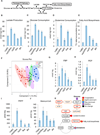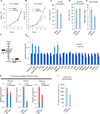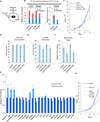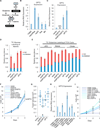Addiction to Coupling of the Warburg Effect with Glutamine Catabolism in Cancer Cells
- PMID: 27732857
- PMCID: PMC5108179
- DOI: 10.1016/j.celrep.2016.09.045
Addiction to Coupling of the Warburg Effect with Glutamine Catabolism in Cancer Cells
Abstract
Metabolic reprogramming is critical to oncogenesis, but the emergence and function of this profound reorganization remain poorly understood. Here we find that cooperating oncogenic mutations drive large-scale metabolic reprogramming, which is both intrinsic to cancer cells and obligatory for the transition to malignancy. This involves synergistic regulation of several genes encoding metabolic enzymes, including the lactate dehydrogenases LDHA and LDHB and mitochondrial glutamic pyruvate transaminase 2 (GPT2). Notably, GPT2 engages activated glycolysis to drive the utilization of glutamine as a carbon source for TCA cycle anaplerosis in colon cancer cells. Our data indicate that the Warburg effect supports oncogenesis via GPT2-mediated coupling of pyruvate production to glutamine catabolism. Although critical to the cancer phenotype, GPT2 activity is dispensable in cells that are not fully transformed, thus pinpointing a metabolic vulnerability specifically associated with cancer cell progression to malignancy.
Keywords: GPT2; LDHA; LDHB; TCA cycle; Warburg effect; anaplerosis; cancer metabolism; glycolysis; lactate dehydrogenase; oncogenes.
Copyright © 2016 The Authors. Published by Elsevier Inc. All rights reserved.
Figures







References
-
- Augoff K, Hryniewicz-Jankowska A, Tabola R. Lactate dehydrogenase 5: an old friend and anew hope in the war on cancer. Cancer Lett. 2015;358:1–7. - PubMed
-
- Baer R, Cintas C, Dufresne M, Cassant-Sourdy S, Schönhuber N, Planque L, Lulka H, Couderc B, Bousquet C, Garmy-Susini B, et al. Pancreatic cell plasticity and cancer initiation induced by oncogenic Kras is completely dependent on wild-type PI 3-kinase p110α. Genes Dev. 2014;28:2621–2635. - PMC - PubMed
-
- Bauer DE, Hatzivassiliou G, Zhao F, Andreadis C, Thompson CB. ATP citrate lyase is an important component of cell growth and transformation. Oncogene. 2005;24:6314–6322. - PubMed
-
- Bensaad K, Tsuruta A, Selak MA, Vidal MN, Nakano K, Bartrons R, Gottlieb E, Vousden KH. TIGAR, a p53-inducible regulator of glycolysis and apoptosis. Cell. 2006;126:107–120. - PubMed
-
- Brownsey RW, Boone AN, Elliott JE, Kulpa JE, Lee WM. Regulation of acetyl-CoA carboxylase. Biochem. Soc. Trans. 2006;34:223–227. - PubMed
Publication types
MeSH terms
Substances
Grants and funding
LinkOut - more resources
Full Text Sources
Other Literature Sources
Miscellaneous

